| John Adams was the second President of the United States. He was a member of both Continental Congresses and he signed the Declaration of Independence. He was the first Vice President of the United States.

 In 1755, he graduated from Harvard University and then went on to study law before being admitted to the Boston Bar in 1758. In 1755, he graduated from Harvard University and then went on to study law before being admitted to the Boston Bar in 1758.
He married Abigail Boylston of Braintree, Massachusetts. Adams went on to write for two different newspapers under two different pen names. He argued both sides of issues using each of his pen names. He remarked that he was "carrying on a dialogue with himself in the two leading Boston newspapers."
In 1770, he ambitiously defended British soldiers in the shooting deaths of five colonists in what was known as the Boston Massacre. He won the acquittal of the commanding officer
and most of the soldiers.

Adams always kept personal diaries, which revealed his true character; he was a much different man from the self-righteous, intellectual he seemed to project in public. When Adams was appointed to the Continental Congress, he made passionate speeches for the rights of colonists to revolt against England and its tyrant King George III. Adams was the first to call for  independence, but the other delegates, thinking that he was obnoxious, rarely listened to him. Adams suspected that history would judge him more kindly than his peers did; he was right. It later became apparent that Adams was politically or morally correct on almost all of the issues. independence, but the other delegates, thinking that he was obnoxious, rarely listened to him. Adams suspected that history would judge him more kindly than his peers did; he was right. It later became apparent that Adams was politically or morally correct on almost all of the issues.
Adams was a member of the Declaration of Independence Committee with Thomas Jefferson, Ben Franklin, Roger Sherman, and Robert Livingston. Jefferson wrote most of the document and John Adams presented it passionately in Congress. The vote passed on the day that became Independence Day, July 4, 1776.
Adams served the new nation as a diplomat, negotiating the Treaty of Paris. He, John Jay, and Benjamin Franklin successfully negotiated the treaty in 1782 and 1783. In the treaty, Great Britain agreed to recognize its former thirteen colonies as the free and sovereign United States of America. From 1785 to 1788, Adams served as diplomatic envoy to Great Britain, a position that would later be held by both his son and his grandson.

 Adams served as Vice President under George Washington because he came in second place during both elections. As Vice President, he limited himself to presiding over the Senate. His detractors called him "His Rotundity" because he was short and heavy. When George Washington refused a third term in 1797, Adams was elected President (1797-1801). Adams served as Vice President under George Washington because he came in second place during both elections. As Vice President, he limited himself to presiding over the Senate. His detractors called him "His Rotundity" because he was short and heavy. When George Washington refused a third term in 1797, Adams was elected President (1797-1801).
In 1797, Adams became the second President of the United States. He was the first President who belonged to a political party - the Federalists. The Federalist Party was formed while George Washington was President. The party believed in a strong central government. Adams, however, was an independent thinker and voted his conscience instead of the "Party Line." This put him at odds with many in his own party.
 While Adams was President, the United States government moved from Philadelphia to Washington, DC. Adams became the first President to live in the White House. The Department of Navy and the Marine Corps were established during his presidency. While Adams was President, the United States government moved from Philadelphia to Washington, DC. Adams became the first President to live in the White House. The Department of Navy and the Marine Corps were established during his presidency.
During Adams' term as President, the dominant issue was the threat of war with France. He maintained his resolve to keep the United States out of war. Although the country's ships fought many battles, war was never formally declared.
In order to silence critics of the possible war with France, Congress approved the Alien and Sedition Acts in 1798. The Alien Act gave the President permission to arrest and deport any foreigner whom he considered to be dangerous. The Sedition Act made it a criminal offense to print false, malicious, or scandalous statements which criticized the government or government officials. In 1799, Adams sent new peace commissioners to France to reopen negotiations. He settled the differences between the countries at the Convention of 1800 and avoided war.

Much to his joy, Adams lived to see his son, John Quincy Adams, follow in his footsteps. His son became the sixth President. Both father and son were born in Quincy, Massachusetts. At the time, the town was called Braintree.
During much of his life, John Adams and Thomas Jefferson were bonded by their love for their country. Later in life, however, politics had them at each other's throats. Finally near the end of their lives, each forgave the other and expressed his feelings in a letter. Both men died on July 4, l826, without getting to read the other's letter.
|

